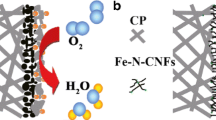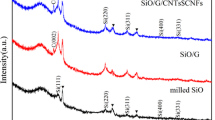Abstract
A facile and immediate two-step electrodeposition method was employed to fabricate a carbon fiber cloth (CFC) coated with Pd deposited on Co nanoparticles (NPs), with Co deposition time of 100 s (denoted as Pd/Co100/CFC). For the sake of comparison, Pd/Co10/CFC and Pd/CFC were prepared by the same method. The characterization was carried out using field emission scanning electron microscopy (FESEM), X-ray diffraction (XRD), energy-dispersive X-ray spectroscopy (EDS), and electrochemical techniques. The FESEM micrographs and XRD results revealed that an increase in Co deposition time results in a change in deposited Pd morphology from dendritic to fine and dispersed NPs, a noticeable reduction in size of Pd NPs, a rise in percentage of alloying, and contraction strain in the Pd/Co100/CFC structure. The Pd/Co100/CFC catalyst showed a mass activity of j p = 1,220 mA mg ‐ 1Pd for formic acid (FA) electrooxidation, and it had 69.1 m2 g−1 electrochemical active surface area (ECSA), which are more than eight and three times higher than those of Pd/CFC catalyst (j P = 140 mA mg ‐ 1Pd , ECSA = 22.8 m2 g−1), respectively. Moreover, comparison of the performance parameters of Pd/Co100/CFC with some other palladium-based electrodes in some recent studies with relatively good results showed that the Pd/Co100/CFC has a great potential as a less expensive, fast and easily prepared, and dramatically active anodic electrocatalyst in the application of direct formic acid fuel cells.






Similar content being viewed by others
References
Wang Y, Chen KS, Mishler J, Cho SC, Adrocher XC (2011) A review of polymer electrolyte membrane fuel cells: technology, applications, and needs on fundamental research. Appl Energy 88:981–1007
Celorrio V, Montes de Oca MG, Plana D, Moliner R, Fermin DJ, Lazaro MJ (2012) Electrochemical performance of Pd and Au–Pd core–shell nanoparticles on surface tailored carbon black as catalyst support. Int J Hydrog Energy 37:7152–7160
Hosseini H, Mahyari M, Bagheri A, Shaabani A (2014) Pd and PdCo alloy nanoparticles supported on polypropylenimine dendrimer-grafted graphene: a highly efficient anodic catalyst for direct formic acid fuel cells. J Power Sources 247:70–77
Cao J, Song L, Tang J, Xu J, Wang W, Chen Z (2013) Enhanced activity of Pd nanoparticles supported on Vulcan XC72R carbon pretreated via a modified Hummers method for formic acid electrooxidation. Appl Surf Sci 274:138–143
Zhang S, Guo S, Zhu H, Su D, Sun S (2012) Structure-induced enhancement in electrooxidation of trimetallic FePtAu nanoparticles. J Am Chem Soc 134:5060–5503
Nassr ABAA, Quetschke A, Koslowski E, Bron M (2013) Electrocatalytic oxidation of formic acid on Pd/MWCNTs nanocatalysts prepared by the polyol method. Electrochim Acta 102:202–211
Ahn SH, Choi I, Kwon OJ, Kim JJ (2012) One-step co-electrodeposition of Pt–Ru electrocatalysts on carbon paper for direct methanol fuel cell. Chem Eng J 181–182:276–280
Zhu F, Ma G, Bai Z, Hang R, Tang B, Zhang Z, Wang X (2013) High activity of carbon nanotubes supported binary and ternary Pd-based catalysts for methanol, ethanol and formic acid electro-oxidation. J Power Sources 242:610–620
Wang D, Xin HL, Wang H, Yu Y, Rus E, Muller DA, Disalvo FJ, Abruna HD (2012) Facile synthesis of carbon-supported Pd–Co core-shell nanoparticles as oxygen reduction electrocatalysts and their enhanced activity and stability with monolayer Pt decoration. Chem Mater 24:2274–2281
Wang R, Wang H, Feng H, Ji S (2013) Palladium decorated nickel nanoparticles supported on carbon for formic acid oxidation. Int J Electrochem Sci 8:6068–6076
Hong JW, Kim D, Lee YW, Kim M, Kang SW, Han SW (2011) Atomic-distribution-dependent electrocatalytic activity of Au-Pd bimetallic nanocrystals. Angew Chem Int Ed 50:8876–8880
Mavrikakis M, Hammer B, Nørskov JK (1998) Effect of strain on the reactivity of metal surfaces. Phys Rev Lett 81:2819–2822
Hsu C, Huang C, Hao Y, Liu F (2012) Au/Pd core–shell nanoparticles for enhanced electrocatalytic activity and durability. Electrochem Commun 23:133–136
Rezaei M, Tabaian SH, Haghshenas DF (2014) Electrochemical nucleation and growth of Pd/PdCo core–shell nanoparticles with enhanced activity and durability as fuel cell catalyst. J Mater Chem A 2:4588–4597
Verlato E, Cattarin S, Comisso N, Guerriero P, Musiani M, Vázquez-Gómez L (2010) Preparation of catalytic anodes for methanol oxidation by spontaneous deposition of Pd onto porous Ni or porous Co. Electrochem Commun 12:1120–1123
Wang R, Wang H, Wang X, Liao S, Linkov V, Ji S (2013) Effect of the structure of Ni nanoparticles on the electrocatalytic activity of Ni@Pd/C for formic acid oxidation. Int J Hydrog Energy 38:13125–13131
Zhang X, Wang H, Key J, Linkov V, Ji S, Wang X, Lei Z, Wang R (2012) Strain effect of core-shell Co@Pt/C nanoparticle catalyst with enhanced electrocatalytic activity for methanol oxidation. J Electrochem Soc 159:B270–B276
Suo Y, Zhuang L, Lu J (2007) First-principles considerations in the design of Pd-alloy catalysts for oxygen reduction. Angew Chem Int Ed 46:2862–2864
Liu L, Pippel E, Scholz R, Gosele U (2009) Nanoporous Pt-Co alloy nanowires : fabrication, characterization, and electrocatalytic properties. Nano Lett 9:4352–4358
Nguyen ST, Law HM, Nguyen HT, Kristian N, Wang S, Chan SH, Wang X (2009) Enhancement effect of Ag for Pd/C towards the ethanol electro-oxidation in alkaline media. Appl Catal B Environ 91:507–515
Miao F, Tao B, Sun L, Liu T, You J, Wang L, Chu PK (2010) Preparation and characterization of novel nickel–palladium electrodes supported by silicon microchannel plates for direct methanol fuel cells. J Power Sources 195:146–150
Wang X, Xia Y (2008) Electrocatalytic performance of PdCo–C catalyst for formic acid oxidation. Electrochem Commun 10:1644–1646
Zhang L, Wan L, Ma Y, Chen Y, Zhou Y, Tang Y, Lu T (2013) Crystalline palladium–cobalt alloy nanoassemblies with enhanced activity and stability for the formic acid oxidation reaction. Appl Catal B Environ 138–139:229–235
Woo S, Kim I, Lee JK, Bong S, Lee J, Kim H (2011) Preparation of cost-effective Pt–Co electrodes by pulse electrodeposition for PEMFC electrocatalysts. Electrochim Acta 56:3036–3041
Jiang Y, Lu Y, Li F, Wu T, Niu L, Chen W (2012) Facile electrochemical codeposition of “clean” graphene–Pd nanocomposite as an anode catalyst for formic acid electrooxidation. Electrochem Commun 19:21–24
Bianchini C, Shen PK (2009) Palladium-based electrocatalysts for alcohol oxidation in half cells and in direct alcohol fuel cells. Chem Rev 109:4183–4206
Sawangphruk M, Krittayavathananon A, Chinwipas N (2013) Ultraporous palladium on flexible graphene-coated carbon fiber paper as high-performance electro-catalysts for the electro-oxidation of ethanol. J Mater Chem A 1:1030–1034
Zhang H, Zhou W, Du Y, Yang P, Wang C (2010) One-step electrodeposition of platinum nanoflowers and their high efficient catalytic activity for methanol electro-oxidation. Electrochem Commun 12:882–885
Radisic A, Vereecken PM, Hannon JB, Searson PC, Ross FM (2006) Quantifying electrochemical nucleation and growth of nanoscale clusters using real-time kinetic data. Nano Lett 6:238–242
Shao M, Sasaki K, Adzic RR (2006) Pd-Fe Nanoparticles as electrocatalysts for oxygen reduction. J Am Chem Soc 128:3526–3527
Wang AJ, Li FF, Bai Z, Feng JJ (2012) Large-scale electrosynthesis of Pd nanodendrites and their improved electrocatalytic properties for methanol oxidation. Electrochim Acta 85:685–692
Nikolić ND, Popov KI, Pavlović LJ, Pavlović MG (2006) The effect of hydrogen codeposition on the morphology of copper electrodeposits. I. The concept of effective overpotential. J Electroanal Chem 588:88–98
Huang XJ, Yarimaga O, Kim JH, Choi Y-K (2009) Substrate surface roughness-dependent 3-D complex nanoarchitectures of gold particles from directed electrodeposition. J Mater Chem 19:478–483
Hsieh CT, Liu YY, Roy AK (2012) Pulse electrodeposited Pd nanoclusters on graphene-based electrodes for proton exchange membrane fuel cells. Electrochim Acta 64:205–210
Trasatti S, Petrii OA (1993) Real surface area measurements in electrochemistry. J Electroanal Chem 327:353–376
Xiao L, Zhuang L, Liu Y, Lu J, Abruna HD (2009) Activating Pd by morphology tailoring for oxygen reduction. J Am Chem Soc 131:602–608
Cheng N, Webster R, Pan M, Mu S, Rassaei L, Tsang S, Marken F (2010) One-step growth of 3–5nm diameter palladium electrocatalyst in a carbon nanoparticle–chitosan host and characterization for formic acid oxidation. Electrochim Acta 55:6601–6610
Wang X, Wang W, Qi Z, Zhao C, Ji H, Zhang Z (2009) High catalytic activity of ultrafine nanoporous palladium for electro-oxidation of methanol, ethanol, and formic acid. Electrochem Commun 11:1896–1899
Hong W, Fang Y, Wang J, Wang E (2014) One-step and rapid synthesis of porous Pd nanoparticles with superior catalytic activity toward ethanol/formic acid electrooxidation. J Power Sources 248:553–559
Hong W, Wang J, Wang E (2014) Bromide ion mediated synthesis of carbon supported ultrathin palladium nanowires with enhanced catalytic activity toward formic acid/ethanol electrooxidation. Int J Hydrog Energy 39:3226–3230
Ren M, Chen J, Li Y, Zhang H, Zou Z, Li X, Yang H (2014) Lattice contracted Pd-hollow nanocrystals: Synthesis, structure and electrocatalysis for formic acid oxidation. J Power Sources 246:32–38
Zhao H, Zhao TS (2012) Highly active carbon nanotube-supported Pd electrocatalyst for oxidation of formic acid prepared by etching copper template method. Int J Hydrog Energy 38:1391–1396
Nitze F, Mazurkiewicz M, Malolepszy A, Mikolajczuk A, Kedzierzawski P, Tai CW, Hu G, Kurzydlowski KJ, Stobinski L, Borodzinski A, Wagberg T (2012) Synthesis of palladium nanoparticles decorated helical carbon nanofiber as highly active anodic catalyst for direct formic acid fuel cells. Electrochim Acta 63:323–328
Wang S, Manthiram A (2013) Graphene ribbon-supported Pd nanoparticles as highly durable, efficient electrocatalysts for formic acid oxidation. Electrochim Acta 88:565–570
Rezaei M, Tabaian SH, Haghshenas DF (2014) The Role of electrodeposited Pd catalyst loading on the mechanisms of formic acid electro-oxidation. Electrocatalysis 5:193–203
Acknowledgments
This work is a part of project number 92006374 with Iran National Science Foundation (INSF). The authors appreciate INSF for financial and technical support. Also, the authors wish to thank the renewable energy organization of Iran (SANA) for the financial support.
Author information
Authors and Affiliations
Corresponding author
Rights and permissions
About this article
Cite this article
Vafaei, M., Rezaei, M., Tabaian, S.H. et al. Facile synthesis of a highly active Pd/Co bimetallic nanocatalyst on carbon fiber cloth via a two-step electrodeposition for formic acid electrooxidation. J Solid State Electrochem 19, 289–298 (2015). https://doi.org/10.1007/s10008-014-2561-5
Received:
Revised:
Accepted:
Published:
Issue Date:
DOI: https://doi.org/10.1007/s10008-014-2561-5




